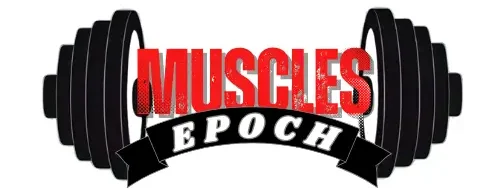Triceps Workouts :When most beginners start training arms, the spotlight usually lands on the biceps. But here’s the reality: if you want strong, defined, and well-balanced arms, your triceps should be a major focus. The triceps make up nearly two-thirds of your upper arm size and are essential for pushing strength and upper body stability.
The good news? You don’t need to be a gym veteran or have fancy equipment to get results. This guide will walk you through simple, beginner-friendly triceps exercises that can be done at home or in the gym. These moves are easy to learn, effective, and designed to help you build strength and definition, even if you’re just starting out.
Why Training Your Triceps Matters
Triceps vs. Biceps: The Bigger Muscle Group
When people think about building bigger arms, the biceps are usually the first muscle that comes to mind. After all, it’s the muscle you flex when someone says, “Show me your muscles!” But here’s the surprising truth: your triceps actually make up around two-thirds of your upper arm’s total muscle mass, while the biceps account for only about one-third.
The triceps muscle has three heads (long, lateral, and medial), whereas the biceps has only two (short and long). This means the triceps has more total muscle volume, giving it greater potential for size and strength gains. If your goal is to build fuller, more muscular arms, neglecting your triceps will severely limit your progress.
Another important point: the triceps play a larger role in pushing movements like bench presses, shoulder presses, and dips. So not only do strong triceps make your arms look bigger, they also improve your overall upper body performance and help support your chest and shoulder workouts.
Focusing on the triceps gives you more visible results in less time—especially when you’re starting out. That’s why any balanced beginner arm routine should put equal, if not greater, emphasis on the triceps.
Functional Benefits of Strong Triceps
Triceps aren’t just for show—they play a crucial role in helping your body move effectively and powerfully in everyday life and in the gym. Because they’re the primary muscles responsible for elbow extension (straightening your arm), your triceps are activated in almost every pushing motion you make.
Whether you’re doing a push-up, bench press, shoulder press, or even lifting a heavy bag overhead, your triceps are working hard behind the scenes. The stronger your triceps are, the easier and safer these movements become. For beginners, building triceps strength means you’ll develop a solid foundation for upper body strength overall.
Beyond workouts, strong triceps support functional movements like pushing open a heavy door, getting up from the floor, or lifting objects above your head. They also help stabilize your shoulders and elbows, which reduces the risk of injury—especially as you begin to lift heavier weights over time.
Simply put, strong triceps equal better performance, better form, and better protection for your joints—whether you’re in the gym or just living your day-to-day life.
Injury Prevention and Balanced Strength
When it comes to strength training, balance is key—not just in how you move, but in how you train your muscles. A common mistake beginners make is focusing too much on the “mirror muscles” like the biceps and chest, while neglecting others like the triceps and back. This creates muscle imbalances that can lead to poor posture, joint strain, and increased risk of injury.
Your triceps work in opposition to your biceps. While the biceps pull, the triceps push. If your biceps are strong but your triceps are underdeveloped, your arms and shoulders can become misaligned, which places unnecessary stress on your elbow and shoulder joints. Over time, this imbalance can cause pain, reduced mobility, and even chronic injuries—especially during compound movements like the bench press or overhead press.
Strong triceps help stabilize the elbow during pressing and pushing exercises, which improves control and reduces the chance of hyperextension or strain. They also support the shoulder by maintaining proper movement patterns in the upper body, especially during activities that involve lifting or pushing.
For beginners, establishing muscular balance early on helps build a strong, injury-resistant foundation. Training your triceps along with your biceps not only makes your arms look more proportionate, but it also helps your joints function better—now and in the long term.
Easy Triceps Exercises You Can Do at Home
Triceps Dips (Using a Chair or Bench)
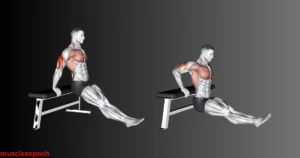
Triceps dips are one of the most effective bodyweight exercises for targeting the triceps—and the best part is, you don’t need any gym equipment. All you need is a sturdy surface like a chair, bench, or low table, making this move perfect for home workouts.
To perform a triceps dip:
- Sit on the edge of the chair with your hands placed next to your hips, fingers facing forward.
- Walk your feet out a few steps so your hips are off the edge and your arms are supporting your weight.
- Slowly bend your elbows to lower your body toward the floor, keeping your elbows close to your sides.
- Stop when your upper arms are about parallel to the ground, then push through your palms to return to the starting position.
This movement isolates the triceps by minimizing involvement from the chest and shoulders, especially if you keep your back close to the chair and maintain controlled motion. For beginners, starting with bent knees makes the move easier. As you get stronger, you can straighten your legs or place your feet on an elevated surface to increase the challenge.
Beyond just building muscle, triceps dips also help improve arm endurance and joint control, making them an excellent foundation exercise for any beginner upper body routine. Just be sure to warm up your shoulders and wrists beforehand, and stop if you feel any discomfort in those areas.
Close-Grip Push-Ups
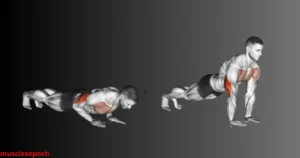
Close-grip push-ups are a simple yet powerful bodyweight exercise that directly targets the triceps, while also working your chest and shoulders. By narrowing your hand placement compared to a traditional push-up, you shift the load away from the chest and onto the back of your arms—making it one of the most effective push variations for triceps development.
How to Do It:
- Start in a standard push-up position with your hands placed directly under your shoulders or slightly narrower.
- Keep your elbows tucked in close to your sides—not flared out—to engage the triceps.
- Lower your chest slowly toward the floor, keeping your body in a straight line from head to heels.
- Press back up to the starting position, focusing on squeezing your triceps at the top.
For beginners, this move can be challenging, especially if you’re new to bodyweight training. To modify:
- Perform the push-up on your knees to reduce the load.
- Elevate your hands on a bench or sturdy surface to decrease intensity.
The key to effectiveness is control—don’t rush through the motion. The slower and more deliberate your reps, the more your triceps will activate.
Close-grip push-ups are not only great for building arm strength and size, but they also help improve core stability and upper body endurance. They require no equipment, making them a go-to move whether you’re at home, at the gym, or even on the go.
Overhead Triceps Extensions (With Water Bottles or Dumbbells)
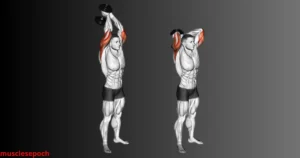
Overhead triceps extensions are a fantastic isolation exercise that targets the long head of the triceps—the largest portion of the muscle. This move helps build both strength and shape in the upper arm, and it’s perfect for beginners because it’s easy to learn and requires minimal equipment.
Even if you don’t have access to dumbbells, you can perform this exercise at home using a filled water bottle, a backpack with books, or any object that’s easy to grip and has some weight.
How to Do It:
- Stand or sit up straight with your feet shoulder-width apart.
- Hold a dumbbell, water bottle, or weighted object with both hands. Raise it overhead until your arms are fully extended.
- Keeping your elbows close to your ears and pointed forward, slowly bend your arms to lower the weight behind your head.
- Stop when your elbows are at about a 90-degree angle, then press the weight back up until your arms are fully extended again.
The key to doing this exercise effectively is elbow stability. Your upper arms should stay still while your forearms do the moving. Avoid letting your elbows flare outward—this keeps the focus on your triceps and protects your shoulders.
This movement is especially beneficial because it places the triceps in a fully stretched position, which increases muscle activation and growth potential. It’s also a great way to improve shoulder mobility and arm control.
Whether you’re aiming to tone your arms or build muscle, overhead triceps extensions are a beginner-friendly, joint-safe option that delivers results when done with proper form and consistency.
Beginner-Friendly Triceps Workouts at the Gym
Cable Triceps Pushdowns
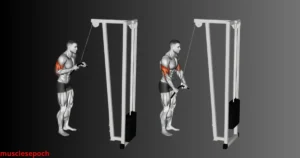
Cable triceps pushdowns are a staple in most gym-based arm workouts—and for good reason. This machine-based movement is one of the most effective ways to isolate and strengthen the triceps, especially for beginners who want to build muscle safely and with control. It’s easy to learn, easy to scale in difficulty, and highly effective at targeting all three heads of the triceps.
How to Do It:
- Stand facing a cable machine with a straight bar, rope, or V-bar attached to the high pulley.
- Grip the handle with your palms facing down (overhand grip), hands about shoulder-width apart.
- Tuck your elbows into your sides and keep them fixed in place throughout the movement.
- Push the handle down by extending your arms fully, squeezing your triceps at the bottom.
- Slowly return to the starting position, resisting the weight on the way up.
One of the biggest benefits of using the cable machine is the constant tension it provides throughout the entire range of motion. Unlike free weights, which lose tension at certain angles, cables keep your triceps engaged from start to finish.
For beginners, this move is great because it encourages good form and makes it easier to control the weight. You can start light, focus on slow and deliberate reps, and gradually increase the weight as your strength improves.
Cable pushdowns are also joint-friendly, making them ideal if you’re recovering from shoulder or elbow discomfort. When done with proper form and a full range of motion, they help build muscle definition, endurance, and pressing strength—all crucial for a balanced upper body.
Skull Crushers (EZ-Bar or Dumbbells)

Don’t let the name intimidate you—skull crushers are a safe and powerful exercise when done with proper form. Also known as lying triceps extensions, this move directly targets the long and lateral heads of the triceps, helping you build arm size and strength efficiently.
Whether you use an EZ-bar, dumbbells, or even light plates, skull crushers are great for beginners who want to isolate their triceps and add variety to their upper body routine.
How to Do It:
- Lie flat on a bench or mat, holding a weight in each hand (or one EZ-bar) with your arms extended above your chest.
- Slowly bend your elbows to lower the weights toward your forehead or just behind your head—keep your upper arms fixed and elbows pointing straight up.
- Stop when your elbows reach about a 90-degree angle.
- Extend your arms back to the starting position, squeezing your triceps at the top.
Tip: If you’re using dumbbells, keep your palms facing each other (neutral grip) for better control and joint comfort.
Skull crushers are especially effective because they stretch the triceps under tension, which promotes greater muscle activation and growth. They also improve elbow stability and control, two important components of long-term upper body strength.
For beginners, it’s smart to start with light weights and focus on smooth, controlled motion. Going too heavy too soon can compromise form and put stress on the elbows.
When performed correctly, skull crushers can be a cornerstone triceps movement, helping you build stronger arms and a more sculpted look over time.
Triceps Kickbacks

Triceps kickbacks may look simple, but they’re one of the most effective and accessible isolation exercises for targeting the back of the arms. This move focuses on the lateral head of the triceps and helps beginners build strength, shape, and definition with minimal equipment—making it a favorite in both gym and home workouts.
All you need is a pair of light dumbbells or even water bottles to get started.
How to Do It:
- Stand with your feet hip-width apart and hold a weight in each hand.
- Hinge slightly at the hips while keeping your back flat and chest up, like you’re leaning forward.
- Bend your elbows to 90 degrees so your upper arms are close to your sides and your forearms point downward.
- Without moving your upper arms, straighten your elbows and “kick” the weights back until your arms are fully extended.
- Pause and squeeze your triceps at the top, then slowly return to the starting position.
Form Tip: The key to making triceps kickbacks effective is keeping your upper arms stationary throughout the movement. Only your forearms should move. Rushing through the exercise or using momentum will reduce its effectiveness.
Kickbacks are especially helpful for beginners because they allow you to focus on mind-muscle connection—really feeling the triceps engage with each rep. They also promote better posture and shoulder control, as the exercise encourages stability and alignment in the upper body.
Triceps kickbacks are a great finisher for your arm workout. After heavier or compound exercises like dips and pushdowns, they offer a lower-impact way to fully burn out the muscle and boost your endurance and tone.
Tips to Maximize Triceps Growth for Beginners
Proper Form Over Heavy Weight
When you’re starting your fitness journey—especially with strength training—it’s tempting to think that lifting heavier weights will lead to faster results. But in reality, proper form is far more important than the amount of weight you’re lifting, especially when training smaller muscle groups like the triceps.
Using correct technique ensures that you’re actually working the target muscle, rather than letting other muscles take over or risking injury. For example, swinging the weights or flaring your elbows during a triceps exercise may allow you to lift heavier, but it shifts the focus away from the triceps and puts strain on your shoulders or wrists.
Why Proper Form Matters:
- Injury Prevention: Good form protects your joints—especially the elbows and shoulders—from unnecessary wear and tear.
- Muscle Activation: Using lighter weights with full range of motion engages the triceps more effectively than lifting heavy with poor control.
- Better Results: Consistent, high-quality reps lead to greater muscle growth and definition over time, even with moderate weight.
As a beginner, your primary goal should be to learn how each movement feels when done correctly. Start with light weights or even just your body weight, and practice slow, controlled reps. Once your form feels solid and natural, you can gradually increase the weight while maintaining good technique.
Remember: strength training isn’t a race. Focusing on form first helps you build a strong, safe foundation—and it will set you up for better gains and fewer setbacks in the long run.
Rest and Recovery
Rest and recovery are just as important as the workouts themselves—especially when you’re building strength and muscle in your triceps. Many beginners make the mistake of training every day without giving their muscles the time they need to heal and grow, which can lead to fatigue, decreased performance, or even injury.
When you work out, you create tiny muscle tears. Your body needs time to repair these fibers, and this process is what actually makes your muscles stronger and bigger. Without proper rest, your muscles don’t fully recover, and progress can stall.
Why Rest Matters:
- Muscle Growth: Recovery allows your triceps to rebuild and grow stronger.
- Injury Prevention: Overtraining increases the risk of strains, joint pain, and burnout.
- Performance Improvement: Giving your muscles time off helps you come back stronger and ready to push harder.
For beginners, it’s usually best to allow at least 48 hours between intense triceps workouts. This doesn’t mean you have to skip training entirely—just focus on different muscle groups or do lighter activity like stretching, yoga, or low-impact cardio.
Also, remember that quality sleep, proper hydration, and balanced nutrition play crucial roles in recovery. Eating enough protein and staying hydrated supports muscle repair and energy levels, so your workouts can be effective.
By respecting rest and recovery, you’ll set yourself up for consistent progress and long-term success in building strong, well-defined triceps.
Consistency and Progressive Overload
When it comes to building strong and defined triceps, two principles are absolutely key: consistency and progressive overload. No matter how effective your workouts are, skipping sessions or not challenging your muscles over time will limit your progress.
Consistency: The Foundation of Success
Consistency means sticking to your workout routine regularly, even on days when motivation dips. For beginners, this might mean scheduling triceps workouts two to three times per week and committing to showing up. Small, steady efforts add up over weeks and months, leading to visible strength and muscle gains.
Remember, progress isn’t about perfection—it’s about making steady, repeated efforts that build habits and momentum. Skipping too many workouts or training sporadically can slow down your results and make it harder to stay motivated.
Progressive Overload: Challenging Your Muscles
Progressive overload is the gradual increase of stress placed on your muscles during exercise. This can be achieved by:
- Adding more weight,
- Increasing the number of repetitions or sets,
- Improving your exercise technique, or
- Decreasing rest time between sets.
When you challenge your triceps beyond what they’re used to, you encourage them to adapt and grow stronger. Without progressive overload, your muscles will plateau, and gains will stall.
For beginners, progressive overload doesn’t mean lifting the heaviest weight right away. It means starting with a manageable load and steadily increasing difficulty as your strength improves. This approach keeps training safe and effective.
In short: Stay consistent with your workouts and aim to gradually make them a little more challenging over time. This winning combination will maximize your triceps growth, improve endurance, and help you achieve lasting results.
Conclusion
Don’t overlook your triceps—these muscles are key to strong, toned, and balanced arms. As a beginner, sticking to simple movements like dips, extensions, and pushdowns can lay the groundwork for long-term progress.
Whether you’re exercising at home or in a gym, these beginner-friendly triceps exercises will help you build the foundation you need. Stay consistent, challenge yourself, and don’t forget to stretch and recover.
Want more beginner workout tips? Check out our workout plan library or subscribe to our newsletter for weekly fitness advice!
